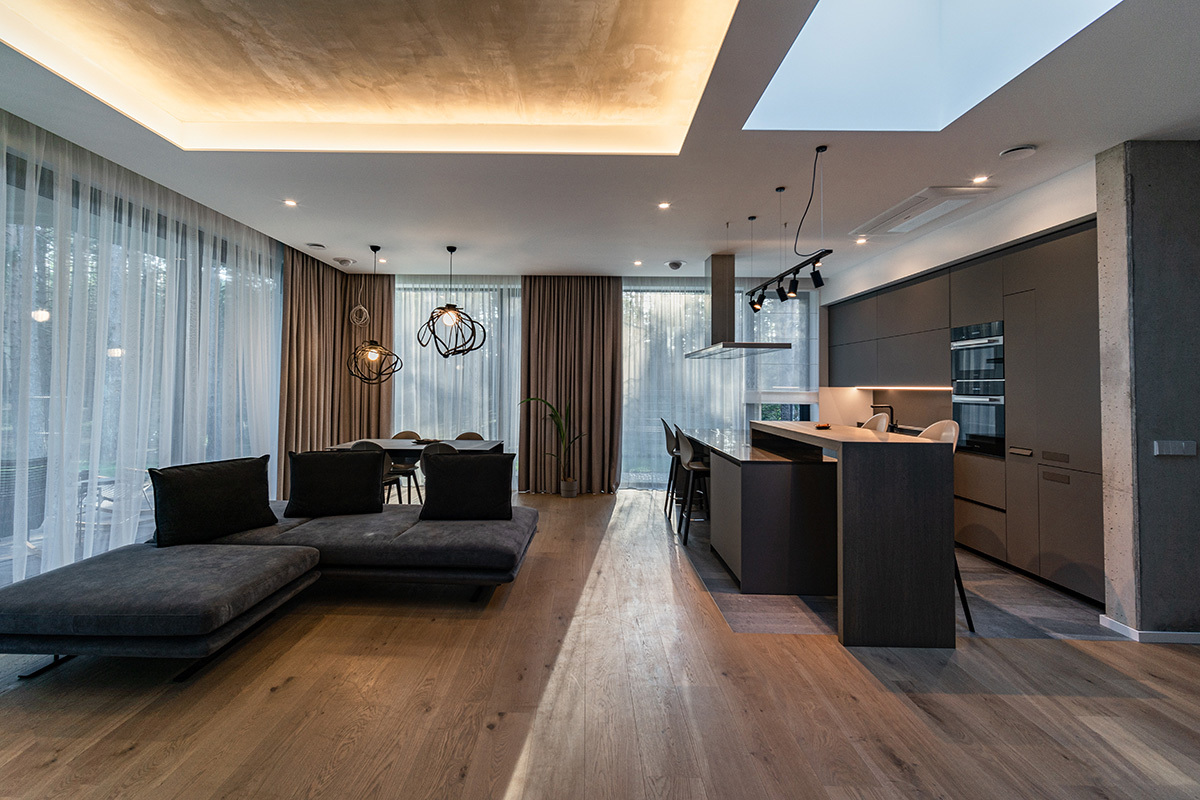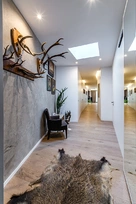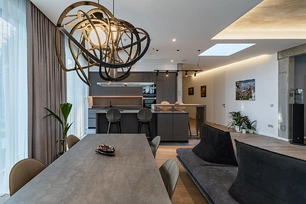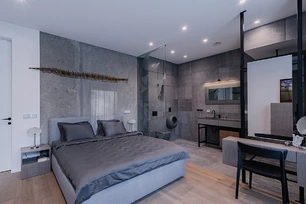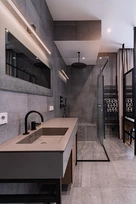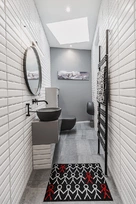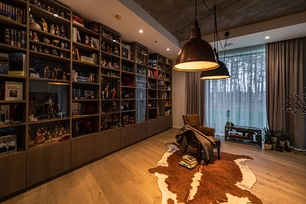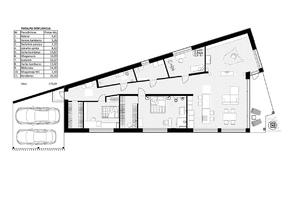Apie projektą:
Bendraautoriai: Kornelijus Dargis (konstruktorius), Asta Rudelevičienė (projeto dalies vadovė)
Šalis: Lietuva
Plotas: 180 m2
Namas miške
Šis konkursui pateiktas privatus namas pastatytas itin žalioje aplinkoje – pušyne. Namo konstruktyvas yra surenkamas gelžbetonis, todėl interjere turėjau galimybę palikti natūralius betono sienų ir lubų fragmentus, juos derinau su balta ir pilka spalvomis. Tokiu būdu išvengiau koloristinės konkurencijos su nuostabiais už langų esančiais vaizdais. Interjerui sušildyti pasirinktos plačios ąžuolinės parketlentės.
Namo forma plane yra labai nestandartinė, kadangi tokią padiktavo sklypo forma ir jame augančios pušys, projektuojant interjerą norėjosi pabrėžti tas nestandartines formas ir jos aiškiai matosi laužytame koridoriuje, nei vieno stataus kampo neturinčioje baltoje vonioje. Projektuoti šias erdves tapo tikru iššūkiu. Atsvara nestandartinei namo formai griežtų linijų baldai, aukštas lubas dar labiau pabrežiančios „paslėptos“ durys, pertvaros.
Kadangi namo pagrindinės erdvės suprojektuotos taip, kad kuo labiau išnaudoti pro langus atsiveriančiais pušyno vaizdais, o pats namas iš miško pusės puikiai įsikomponuoja į aplinką ir tampa organiška jos dalimi.
English:
This private house submitted for contest is built in an extremely green environment - a pine forest. The construction of the house is prefabricated reinforced concrete, that is why I had an opportunity to leave natural fragments of concrete walls and ceilings in the interior combining them with white and grey colours. Thus, I avoided coloristic discord with the images outside my window. Wide oak parquet panels were chosen to heat the interior.
The form of the house in the plan is extraordinary, as it was dictated by the shape of the plot and the pines growing in it. Purpose of Interior design was to emphasize these unusual forms and they are clearly visible in a broken corridor or a white bath without any steep corners. Designing these spaces was a real challenge. A counterweight to the non-standard form of the house is furniture with strict lines, “hidden” doors and partitions that further underlines the high ceiling.
Main spaces of the house are designed to make the most of the view of the pine forest through the windows, and the house itself from the forest side perfectly integrates into the environment and becomes an organic part of it.
Nuotraukos: Aurelija Asinavičiūtė
© 2025 visos teisės saugomos
Norėdami išsaugoti, prisijunkite.
Siekdami užtikrinti geriausią Jūsų naršymo patirtį, šiame portale naudojame slapukus.
Daugiau informacijos ir pasirinkimo galimybių rasite paspaudus mygtuką „Nustatymai“.
Jei ateityje norėsite pakeisti šį leidimą, tą galėsite bet kada galėsite padaryti paspaudžiant portalo apačioje esančią „Slapukų nustatymai“ nuorodą.
Tai portalo veikimui būtini slapukai, kurie yra įjungti visada. Šių slapukų naudojimą galima išjungti tik pakeitus naršyklės nuostatas.
| Pavadinimas | Aprašymas | Galiojimo laikas |
|---|---|---|
| storage_consent | Šiame slapuke išsaugoma informacija, kurias šiuose nustatymuose matomų slapukų grupes leidžiate naudoti. | 365 dienos |
| PHPSESSID | Sesijos identifikacinis numeris, reikalingas bazinių portalo funkcijų (pavyzdžiui, galimybei prisijungti, užildyti užklausos formą ir kitų) veikimo užtrikinimui. | Iki naršyklės uždarymo |
| REMEMBERME | Prisijungimui prie asmeninės paskyros portale naudojamas slapukas. | 1 mėnuo |
| OAID | Portalo vidinės reklaminių skydelių valdymo sistemos slapukas. | 1 metai |
| __eoi | Saugumo paskirtį atliekantis Google paslaugose (Google AdSense, AdSense for Search, Display & Video 360, Google Ad Manager, Google Ads) naudojamas slapukas. | 6 mėnesiai |
| sender_popup_shown_* | Naujienlaiškio užsakymo formos nustatymai. | 1 mėnuo |
Slapukai skirti informacijos apie portalo lankomumą rinkimui.
| Pavadinimas | Aprašymas | Galiojimo laikas |
|---|---|---|
| _ga | Google Analytics statistikos slapukas | 2 metai |
| _ga_* | Google Analytics statistikos slapukas | 2 metai |
Rinkodaros arba reklamos slapukai, kurie naudojami siekiant parodyti pasiūlymus ar kitą informaciją, kuri galėtų Jus sudominti.
| Pavadinimas | Aprašymas | Galiojimo laikas |
|---|---|---|
| test_cookie | Naudojamas Google paslaugose (Google AdSense, AdSense for Search, Display & Video 360, Google Ad Manager, Google Ads). | 15 minučių |
| __Secure-3PAPISID | Naudojama Google paslaugose vartotojo nustatymų ir informacijos saugojimui. | 13 mėnesių |
| __Secure-3PSID | Naudojama Google paslaugose vartotojo nustatymų ir informacijos saugojimui. | 13 mėnesių |
| _fbp | Facebook platformos slapukas. | 90 dienų |
| _fbc | Facebook platformos slapukas. | 90 dienų |
| datr | Facebook platformos slapukas. | 1 metai |

